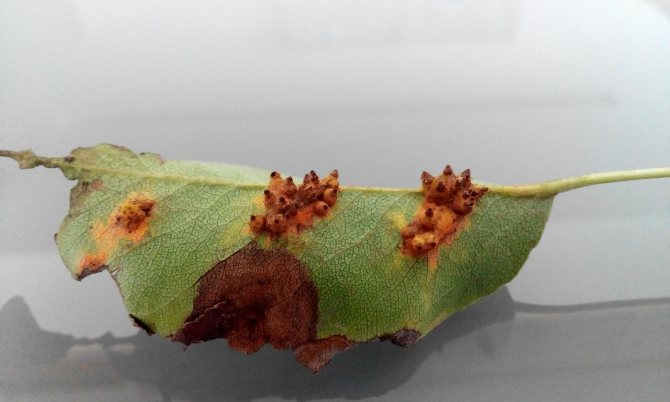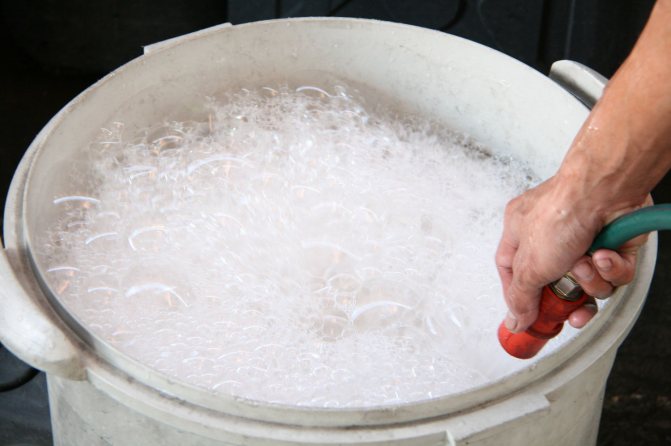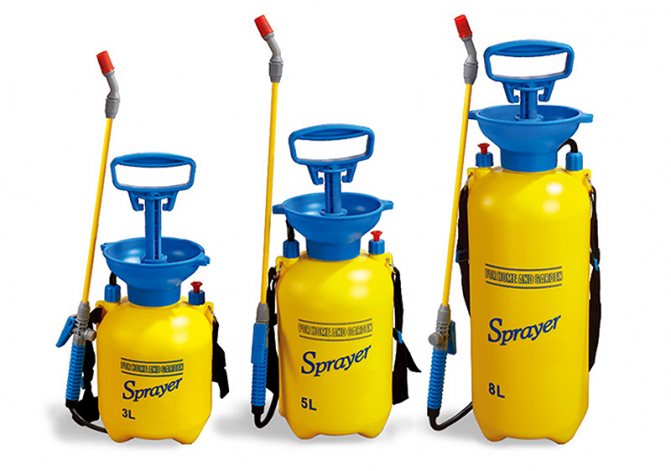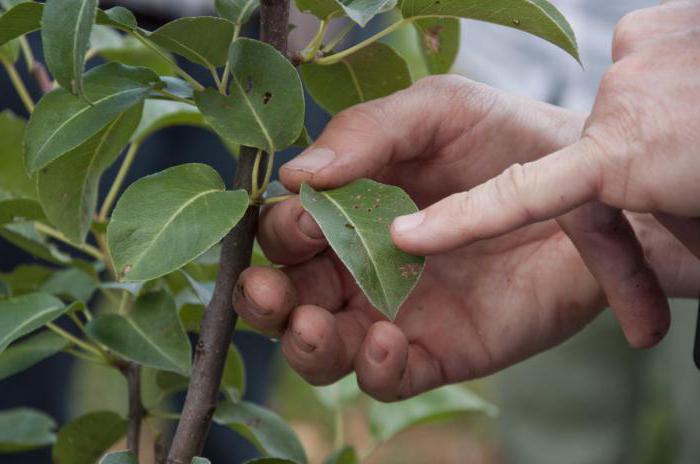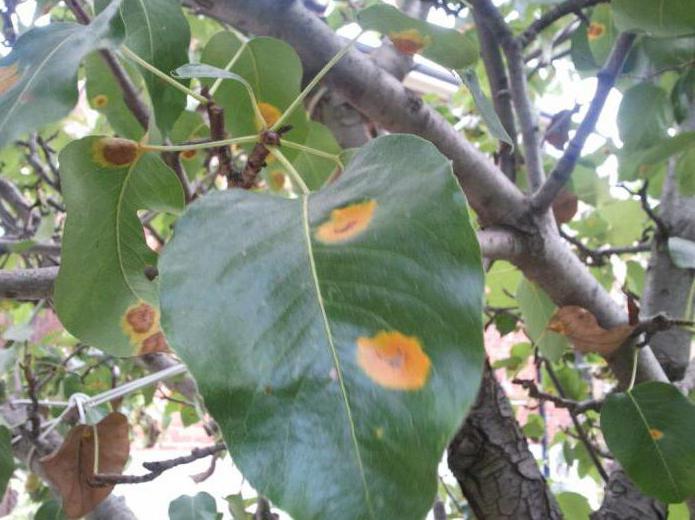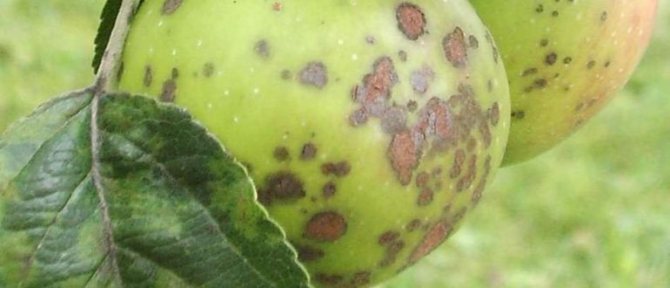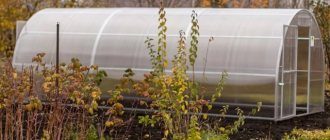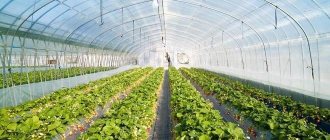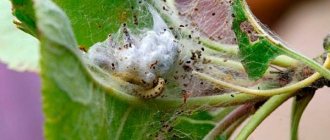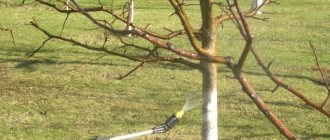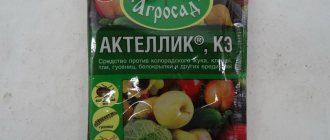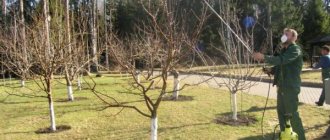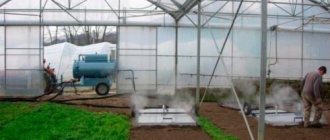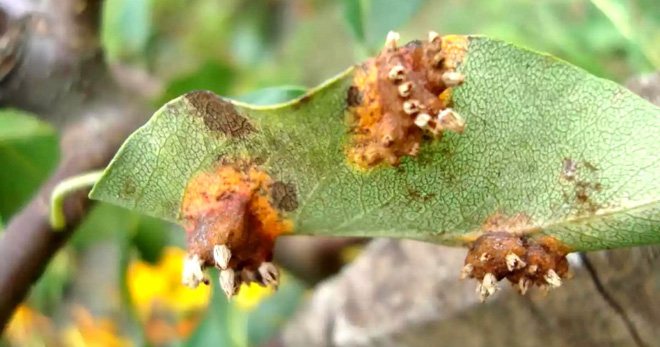
Many trees in the garden can suffer from leaf deformation, which can cause enormous damage to the plant as a result. If even small foci of the disease are found, you need to know how to treat rust on a pear and how to do it correctly in order to minimize negative consequences.
From what you can process a pear in the fall
In autumn, pears are treated against diseases and pests, pathogens and larvae of which winter well in the soil, fallen leaves or damaged tree bark. In the first case, these are fungal diseases that cause tremendous damage to fruit trees during the growing season.
- Scab caused by fungal spores is a lot of trouble for gardeners. The most experienced will notice the first signs in the spring. Platinum sheets become covered with yellowish spots, which swell and burst over time. The leaves lose their gloss and rich green color, acquiring light green or olive shades. If timely measures are not taken, fungal spores multiply rapidly, damaging shoots, inflorescences and fruits. The bark on the branches also swells, deforms, or bursts. Irregular brownish growths appear on pears. The plant itself takes on an unkempt appearance with gnarled shoots. The fruits accordingly lose their commercial qualities and cannot be stored. Moreover, there is an opinion that they should not be eaten. Autumn is a good time for treating scab on a pear, because strong antifungal drugs can be used without fear for the quality of the fruit.
- Fruit rot can destroy up to 80% of the crop. Moreover, not only pears but also apple, plum and quince are affected. In the southern regions, it threatens peaches and apricots. In spring, spores infect leaves and inflorescences. They take on a yellow or gray-yellow tint. Peduncles most often fall off. If the infection occurred in the summer, then dark spots appear on the fruits, which feel softer to the touch than other fruits. The spots grow quickly, the pear flesh darkens and softens. Small whitish growths appear around. These are the capsules in which the fungus develops. Over time, they burst, and the wind carries the spores throughout the garden. The fruit is not suitable for human consumption or processing. Not removed from the branches, they quickly mummify and become a source of new lesions.
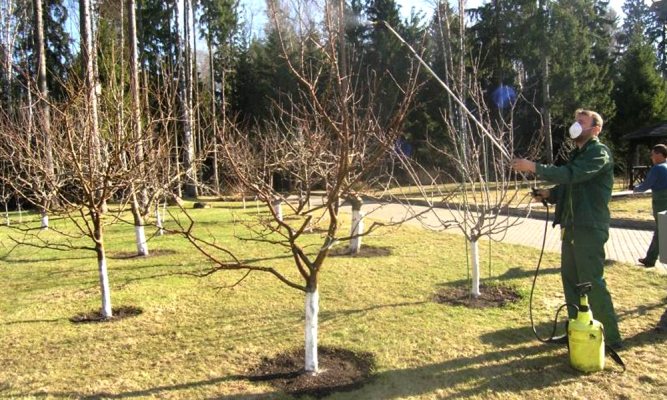

- Rust will not kill the harvest in one year, but if you ignore it, it can lead to the death of the tree. The first signs appear in the middle of summer in the form of small brown or reddish spots on the leaves. By autumn, small cone-shaped growths form on the reverse side of the leaf plates. This is the habitat of spores. If you do not process the pear from rust in the fall, then you will have to face the disease in early spring. Most likely, not only leaves or shoots will be damaged. The bark on the branches becomes covered with reddish spots, swells and bursts.
Attention!
Rust does not only spread between plants of the same species. Fungal spores can infect apple trees, and especially junipers. Therefore, when detecting signs of the disease, it is necessary to spray in the fall from rust not only a pear, but also juniper bushes.
There are many other diseases, from which the autumn processing of pears will not interfere. Among them are powdery mildew, stem rot and milky shine.
If we talk about pests, then it is worth noting the pear mite, leaf beetle and various types of aphids that hibernate under the bark of a tree or in fallen leaves. In the spring, they become active, move to the leaves and feed on their juice.
As a rule, the signs of damage by these pests are similar. The leaves become small, curl, dry and crumble. The appearance of a pear mite can be determined by a kind of swelling on the back of the leaf plates.
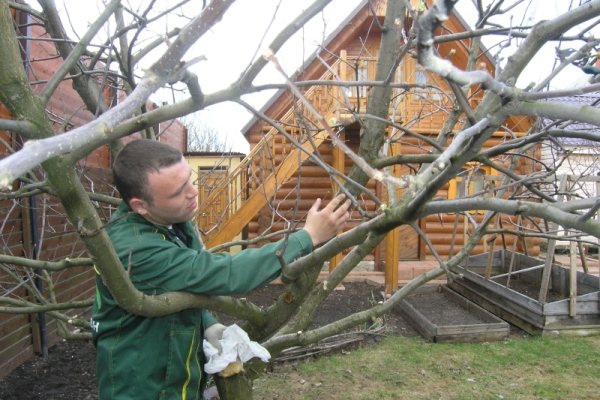

The result is pretty disastrous. The pear begins to lag behind in development, the yield falls. In addition, insects can become carriers of fungal diseases and viral infections. In general, a weakened pear is susceptible to disease, does not tolerate wintering well.
It is worth paying attention to the soil in the root circle. The larvae of the moth and May beetles love to settle in the roots of trees. In spring and summer, not only foliage, but the root system, shoots and fruits suffer from them.
Autumn is not only a good period for treating pears and other fruit trees, but also a good time for preventive treatment. With its help, you can well prepare the plants for winter, and in the spring do not rush to carry out the first spraying.
Best fungicides
Do not forget that fungicides must be changed. You cannot use the same funds for two seasons in a row. The result is the addiction of fungal microorganisms, and as a result, their complete resistance, that is, immunity. To avoid this, some funds are changed during the season, others once a year.
In fact, there are a lot of drugs on the market today, in each store you will be offered a huge selection. Cumulus DF is ideal for pears. It is used for processing after flowering, with an interval of 10-14 days, each time reducing its concentration by a third. The drug "Propi Plus" has proven itself very well. And the Bordeaux mixture is already a classic in horticulture.
Today we talked about how to treat pear disease. Rust is a serious bacterial disease that can lead to the loss of not only the crop, but also the tree itself. Therefore, the gardener should always be on the lookout. First of all, it is very important to carry out prevention, and if you missed the treatment and symptoms of the disease appear, then take the treatment so as not to put other gardens at risk.
Preparing pears for autumn processing
Before starting to deal with rust or scab on a pear in the fall, thorough preparation is carried out.
- All damaged branches are cut off;
- They clean the trunk from all kinds of growths, swellings, flaky bark. It is advisable to cover the root circle with a film or tarpaulin so that mushroom spores do not fall into the ground.
- Remove the fruits left on the tree.
- Fallen leaves, cut shoots are removed and burned.
- The root circle is cut out and dug up.
Only comprehensive control measures will help to cope with rust and other fungal diseases on the pear in the fall.
Prevention
To prevent infection, the fruit tree is regularly pruned, fertilizers are periodically applied to the soil. At the end of the leaf fall, the fallen leaves are removed and burned. The soil around the trunk is cleared of weeds and loosened during the summer. In the fall, the trunk circle is dug up.
The condition of the trees is constantly monitored. If suspicious reddish or brown spots are found, the infected parts are cut off and treatment is started. All cracks, ulcers and other damage to the bark that appear are disinfected and covered with garden pitch. Sanitary and formative pruning is performed twice a year to improve crown ventilation.


How and what to treat a pear in the fall from diseases
If in the summer, gentle methods are used to combat pear diseases, namely the use of biological products and folk remedies, then in the fall you can use chemicals or fungicides.
How to treat a pear from rust in the fall
If rust on the leaves of the pear manifested itself closer to autumn, then you should not postpone processing until the spring. Fungal spores wake up quite early and spread quickly. In addition, with large-scale lesions, it is unlikely that it will be possible to cure a pear from rust in one autumn. In autumn, pears are sprayed with the following compositions for treatment:
- A solution of urea or urea in a proportion of 0.7 kg of the product per 10 liters of water. This solution is used not only to spray trees, but also to process the soil around them.
- Suspension of colloidal sulfur. It is prepared as follows: 40 grams of powder is thoroughly crushed and dissolved in 1 liter of water. After receiving the suspension, it is poured into a bucket of water. Sulfur does not dissolve well, but it settles well on the shoots, providing a healing and protective effect.
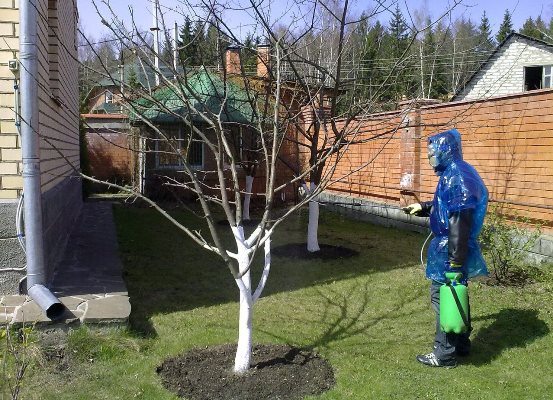

- Good results in the treatment of pears from rust in the fall are shown by the drug "Svor", especially if it is used in conjunction with the antibacterial agent "Fitoldavin".
For the prevention of rust (and it should be done without fail if a juniper grows on the site), copper-containing preparations are used - Bordeaux liquid or a solution of copper sulfate.
Attention!
Before processing, be sure to inspect the shoots. The diseased are cut into a ring or 5-7 cm below the affected area. The growths are removed from the trunk and skeletal branches.
How to process a pear in the fall from scab
Scab is an extremely dangerous disease in that it spreads quickly. Many garden crops, such as gooseberries, are ill with them. And fungal spores have the ability to adapt to the action of drugs.
Fungicides "Horus" and "Tolsin-M" will help to fight scab on a pear in autumn. These drugs have a powerful effect and are able to accumulate in plant tissues. Therefore, they are not recommended for use during the growing season. In autumn, 2-3 sprays are carried out, alternating between them and more gentle antifungal agents - Bordeaux mixture or "Fitosporin". They should also cultivate the soil under pears.
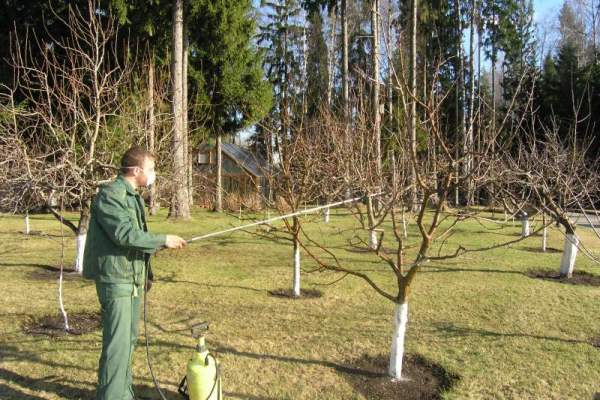

Fighting fruit rot on a pear in autumn
Treatment of trees from fruit rot begins immediately after the first signs of the disease are detected. Measures to combat pear fruit rot in the fall are as follows:
- thorough cleaning of all plant residues;
- spraying plants with fungicides "Hom", "Topaz", "Abiga-Peak";
- treatment of the root circle with a solution of "Fitosorin", copper or iron vitriol, they also spray the crown with the purpose of prevention.
Attention!
Experienced gardeners recommend growing varieties that are resistant to fruit rot, regularly inspect trees, and do not store spoiled fruits. If fruit rot manifests itself on stored fruits, do not lay them in compost heaps and do not throw them away within the site.
Processing pears in the fall from other diseases
In the fall, pears are also sprayed for other diseases of fungal origin. To cope with powdery mildew, various forms of rot and milky shine will help treat trees with Bordeaux mixture, copper sulfate, or Fitosporin solution.
Do not forget about the cultivation of the soil under pears.
Pruning the affected tree
Treating a pear necessarily involves pruning. Therefore, take a sharp pruner, prepare a garden pitch and inspect the plant well. Shoots with serious lesions must be cut at least 5 cm below the main lesion. Skeletal, rigid branches must be shortened even more, by about 10 cm. Places of cuts must be well covered with garden pitch. After that, it is recommended to carry out additional feeding so that the tree can restore its own strength.
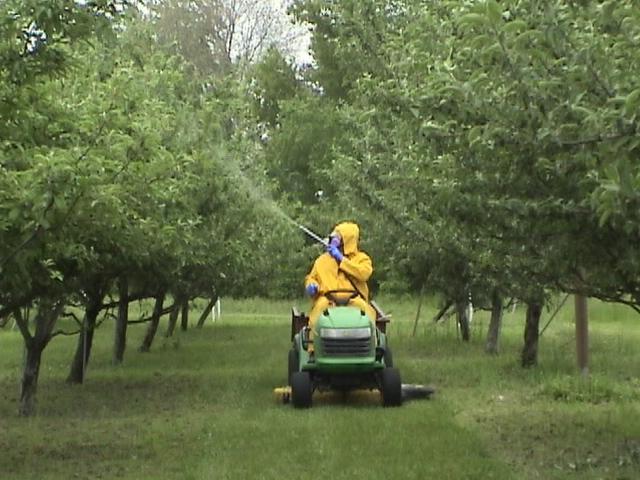

Rules for processing pears in the fall from pests
Autumn is perhaps the best period for treating pears from pests. Do not think that most of them will die in winter. If in the summer traces of the vital activity of a pear mite or aphids were seen on the trees, then the trees are sprayed with such insecticides as "Acrobat", "Inta-Vir" or "Karate".
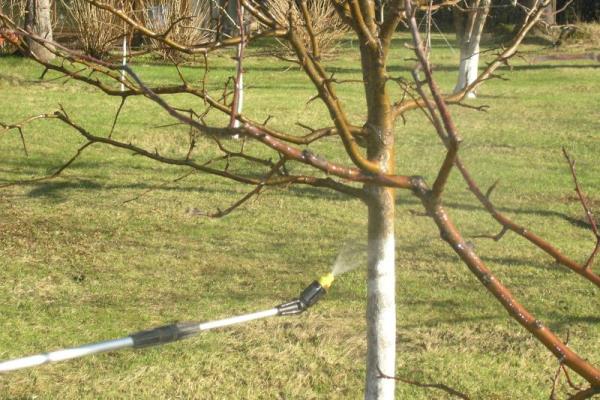

Processing is carried out by spraying or spraying a solution prepared according to the instructions.
Modern means
Based on the experience of modern gardeners, we can say that the best remedy for pear rust is Topaz fungicide. Inexpensive, very effective and practically harmless, it is the most purchased product of all that is on the market year after year. The first treatment is traditionally carried out when the buds on the trees have just begun to bloom. The second is repeated immediately after flowering, and the third - two weeks after the second. This is usually enough to protect your plantings from rust.
Be sure to keep in mind that the pear suffers from this disease much more than the apple tree. She can completely shed her leaves and go unprepared for the winter. In this case, the tree will die almost inevitably, especially if the winter is frosty. Therefore, the processing of pears cannot be neglected in any case.


Rules for processing pears in the fall for the winter
Almost all treatments are carried out by abundant spraying of preparations on the shoots and spraying or watering the root circle with them. It is best to use a garden sprayer with a long hose and large capacity.
Pears are processed in dry and calm weather. It is desirable that there is no precipitation in the next day. In this case, the solution will have time to be absorbed and activate its effect.
To perform work, use closed clothing and personal protective equipment: gloves, glasses, respirators. Before processing, you need to carefully read the instructions for use of a particular drug and be careful. After all, large areas will have to be processed.
Resistant varieties
Breeders of Russia and other countries are seriously concerned about the protection of fruit crops from fungal diseases. As a measure to reduce the risk of tree disease, experts advise planting pear varieties with high rust resistance, among which the following are the most popular:
- summer - "Skorospelka", "Williams", "Ilyinka", "Sugar", "Bere Zhiffar", "Chizhovskaya";
- autumn - "Autumn Dikanka", "Red Borovinka";
- winter - "Bere Ligel", "Belorusskaya late", "Yakovlevskaya", "Nika".
Causes of infection and factors affecting the spread
The pathogenic fungus Gymnosporangiumsabinae, which causes a rust infection, most often settles on junipers, as well as on some other conifers. It is the juniper that becomes the first carrier of the infection. Moreover, it can be located far outside the garden. The spores of the fungus are spread by wind and water, often over very long distances. A single juniper bush with rust can infect trees and shrubs within a radius of up to 50 km.
A feature of the spread of this fungus is cross-infection. The disease is not transmitted from pear to pear and from one juniper bush to another. Spores ripening at the end of summer on the leaves of a fruit tree, scattering, infect the juniper, which, in turn, infects other fruit trees the next spring.

